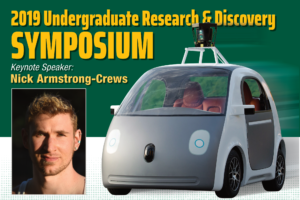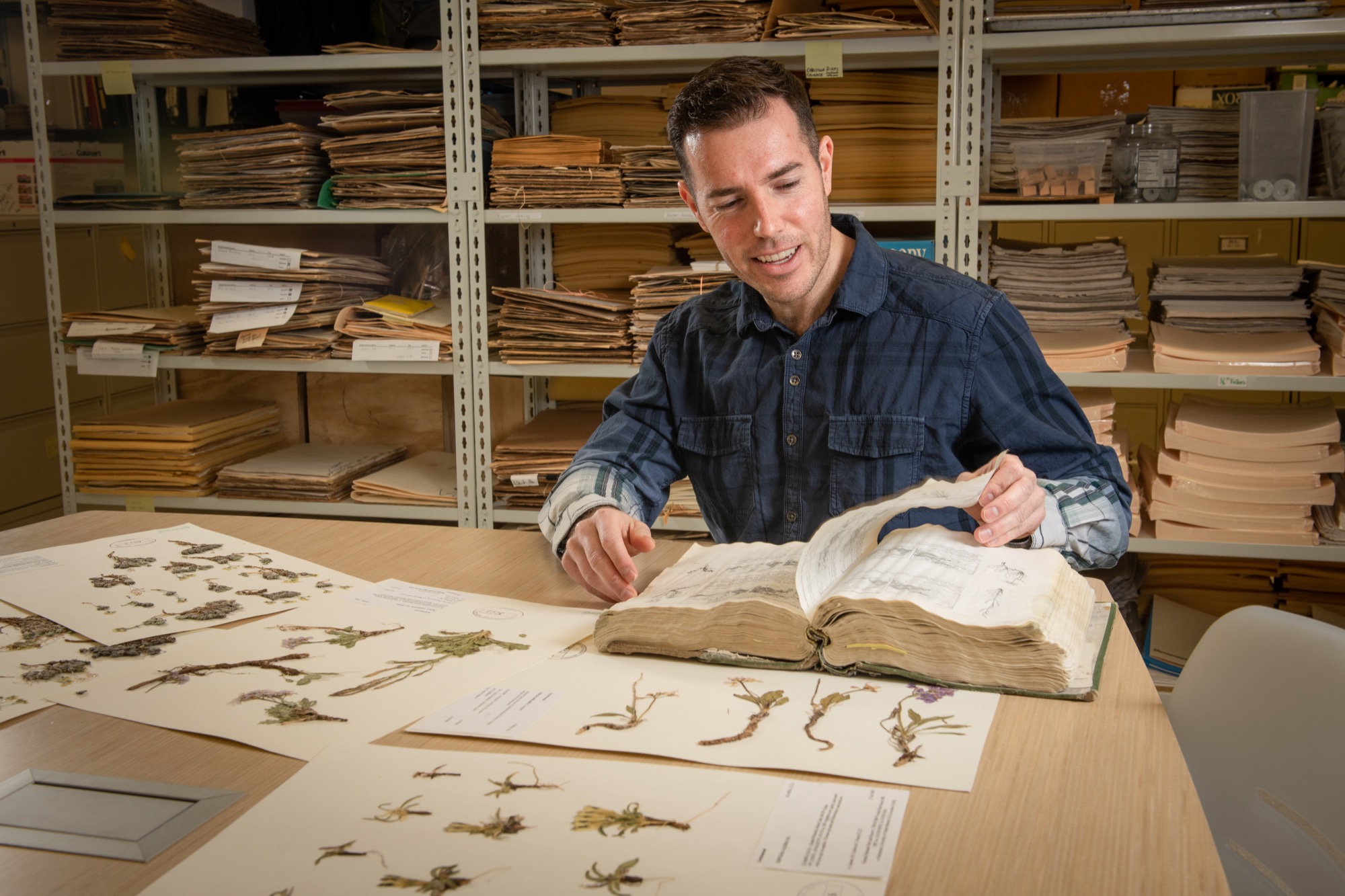The roboticist returns
by cmmyers |

UAA alumnus and roboticist Nick Armstrong-Crews is returning to campus to deliver the keynote address at the 2019 Undergraduate Research and Discovery Symposium.
Imagine a world where there were no auto accidents, commuters were free from the stress of rush hour gridlock, vehicles traveling our nation's highways and interstates did so in a safe and courteous manner and parking lots were a concept of the past. It seems too good to be true, but for UAA alumnus Nick Armstrong-Crews, it's a world he spends a lot of time imagining.
Since earning three bachelor's degrees from UAA - B.S. Computer Science '03, B.S. Math '04, B.S. Natural Sciences '05, with minors in Applied Statistics and French - Armstrong-Crews has spent the last 14 years in the tech industry. He studied robotics at Carnegie Mellon University, advanced robotic perception fieldwide in MIT's Lincoln Laboratory, and built his own tech startup, Heuristic Labs, which designed and launched the 3D camera in the iPhone X. He was then recruited out West to Silicon Valley to work for the ultimate tech company, Google. He spent his first two years at Google working on various projects before transferring over to the company's self-driving car division, which branched off in 2016 as a stand-alone subsidiary and relaunched itself as Waymo.
Needless to say, the roboticist has been busy at the forefront of the world's cutting-edge technology and will be delivering the keynote address at this year's Undergraduate Research and Discovery Symposium held April 18-19. Armstrong-Crews plans to detail the incredible advances in machine learning, 3D sensing, and other disciplines that are jointly making the possibility of self-driving cars a reality in the not so distant future.
"It's the most exciting robot project in the world," said Armstrong-Crews. "It's the closest thing we have to an embodied artificial mind. It's incredibly capable compared to the other robot systems. It can recognize many kinds of objects and reason about with other agents in the world. It can plan the future of what those agents might do and then also move safely and intelligently around them."
The new millennium
Like many 30-somethings, Armstrong-Crews grew up on the wave of the '90s tech boom that washed into the early 2000s with the advent of smartphones, social media and the tidal wave takeover of the internet, which forever altered the American, and worldwide, landscape. As an elementary school kid, he'd been into math, but by the time he was 12 he'd saved enough of his PFD's to buy his own computer and his interests shifted to "artificial intelligence" as it was called then, which Armstrong-Crews said is now more widely referred to as machine learning. It was an exciting time for technology, as it seemed advances in the industry were on warp speed with companies like Apple, Android and Microsoft jockeying to churn out the latest and greatest computers and handheld devices every year. It's the tech world Armstrong-Crews grew up in and inspired him to pursue a career in robotics.
"My first job was doing internet tech support at the local internet provider, Mosquito Net in Fairbanks," he said. "I could tell right then that these computers were going to be a big deal and very lucrative. So I decided to move toward computer sciences in my learning."
After graduating from high school, Armstrong-Crews packed his bag, following his high school sweetheart to attend UAA. It was the early 2000s and the university's computer science department was in its infancy, but Armstrong-Crews said the tiny department with two professors is what gave him an unparalleled undergraduate experience and a leg up against the steep competition when applying to grad school.
"When I started in the computer science department was small and I ended up taking most of my courses with Kenrick Mock," he said, explaining that taking the majority of his classes with the same professors provided a continuity and personal experience he hasn't had at larger schools. "He [Kenrick Mock] helped me branch out to opportunities outside the classroom, like undergraduate research, and that really put me on a good track towards grad school."
Over the course of Armstrong-Crews' undergraduate career at UAA, he not only focused on his studies, but he was also actively engaged on campus through the UAA Honors College, as a member of Phi Kappa Phi Honor Society, and also as a member of several clubs including the Freethinkers Society, Amnesty International and the UAA Math and Computer Science clubs. Additionally, he also worked in UAA's Computer Lab.
"I was a part of the community in a way that I don't feel like I could have been at a larger school down in the Lower 48," he said.
The future is awesome
Whether Armstrong-Crews knew it at the time, when he first embarked on his journey into the world of tech, the culmination of his hard work thus far has landed him in a position to create technology with the power to change transportation as we know it. Grandiose, yes, but not that far out of reach according to Armstrong-Crews. His goal is to use his knowledge of machine learning to possibly create a world where death from auto accidents might not exist, and this prospect excites and propels him forward.
Since landing his current role at Waymo, Armstrong-Crews has dedicated himself to helping solve one of the nation's leading causes of death each year: auto accidents. The numbers stretch beyond the one million mark with 94 percent of the accidents caused by human error. Armstrong-Crews wants to eradicate this problem from our nation's highways and interstates.
"I think this [technology] is going to have a revolutionary impact, with some impacts immediately and then some longer term," he said. "I don't think we're going to see all our cities transformed and all the parking lots removed immediately, but I think one day we will and we're getting closer to that everyday."
According to Armstrong-Crews, the average car on the road has less than 10 percent utilization - it's mostly stationary, taking up space in a parking lot. But, the idea, the dream with autonomous, self-driving cars, is that they will constantly be on the move. Picking people up and dropping them off at various locations, continuously throughout the day and night. Parking lots and garages would disappear, allowing cities to transform the vast wasted spaces into more productive, usable spaces like housing, workplaces or common gathering place. The possibilities are endless. People will also be able to live closer to where they work, eat, shop and recreate, much like in some of the nation's larger cities, but this would be widespread across the country from large metropolitan areas to suburban and rural towns.
"Eventually when all of the cars on the road are autonomous they can coordinate much more efficiently," Armstrong-Crews said. "They won't need to slow down at stop lights, there won't be stop lights because they would have already coordinated who gets to go when."
In the future, Armstrong-Crews says autonomous vehicles will be incredibly precise and events like traffic jams will be part of our society's distant past. He said road and highway space will become much more efficient compared to now, where even during bumper-to-bumper traffic, only 25 percent of the roadway is being utilized. He even speculates that the number of roads for transportation of people, goods and services will shrink.
It's a world that's hard to imagine, but one he and his colleagues at Waymo are working diligently to create. Recently, Waymo launched their autonomous taxi service in Phoenix, Arizona, and Armstrong-Crews said the company has plans within the next couple of years to roll this service out to other cities across the country.
"We're hoping that we will come to a point where people will choose not to own cars because it will be more expensive for them to take rides in their own car than it is to take an autonomous hailed ride from us," said Armstrong-Crews. He explained that Waymo is not the only company making great strides in this new technology and he believes there will be many options in the future for consumers to choose from when it comes to autonomous vehicles.
Homecoming
For Armstrong-Crews, life is about to come full circle when he returns to campus to deliver the keynote at this year's Undergraduate Research and Discovery Symposium. The yearly event hosted by the UAA Honors College celebrates students' undergraduate research across the university. The free two-day program encourages scholarly discussion between students, faculty and the community, and will include Armstrong-Crews' keynote address.
"I couldn't turn down such an honor and I'm really beside myself with gratitude," said Armstrong-Crews of his upcoming speech. He said it had been more than five years since he'd been back to Alaska, but last year he visited with his new wife. "Touring around it was really powerful for me. I really felt like I was at home, and part of that was going home to Fairbanks and visiting family and friends that I grew up with, but part of that was visiting UAA."
Armstrong-Crews said he wandered the halls of UAA, peeking inside the classrooms he spent hours of his day listening to lectures, and it was bittersweet as his former self and new one collided in the familiar campus buildings he'd once called home. Everywhere he looked there were little reminders of his undergraduate days, from his name on the senior Wranglers plaque in the math department, to a photo of him in the library.
"It's really just amazing to come back and still feel like I'm a part of the community," he said. "And being invited back is really touching and I'm hoping that I can give back in some way."
Join Armstrong-Crews for his keynote address, "Self-driving cars are here ... and they're awesome!" on Thursday, April 18, at 7 p.m., in the Wendy Williamson Auditorium. The lecture is free and open to the public. For more information, visit the Undergraduate Research and Discovery Symposium website.
Written by Catalina Myers, UAA Office of University Advancement
 "The roboticist returns" is licensed under a Creative Commons Attribution-NonCommercial 4.0 International License.
"The roboticist returns" is licensed under a Creative Commons Attribution-NonCommercial 4.0 International License.














